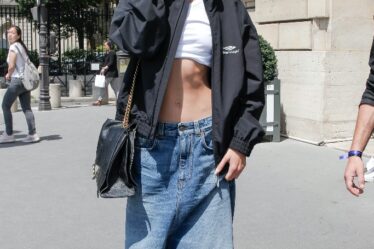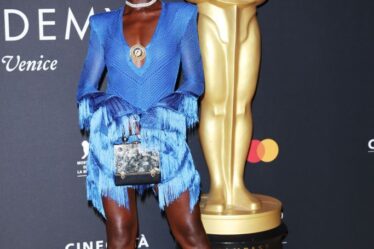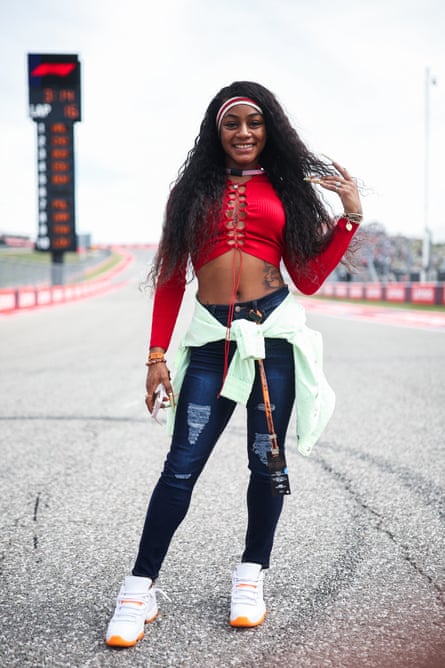
Serena Williams will receive the Fashion Icon award at the high-profile CFDA awards in New York next monthin November. As a sharp dresser with her own clothing line, an honour from the fashion industry makes sense. But this is also the first time an athlete has got this award. It’s a sign of the increasing closeness between sport and fashion – something set to increase in the run-up to the Paris Olympics next year, which will be sponsored by the world’s biggest fashion conglomerate, LVMH.
According to a report by the trend analyst Lefty, alliances between sports and fashion have generated $78.5m (£64.7m) in earned media value (EMV) – the metric that measures the earnings a brand can expect from mentions on social media – so far this year.
Major fashion houses are working with sportspeople in unprecedented ways. When top-10 tennis player Jannik Sinner took a Gucci monogrammed bag on to the court at Wimbledon, it was the first time a high-end luxury luggage piece had been brought on court, according to the label. Emma Raducanu has been an ambassador for Dior since her US Open win in 2021.
Stars such as Arsenal’s Bukayo Saka sit front row at fashion shows for brands such as Burberry. Prada outfitted the Chinese team in suits at the Women’s World Cup, and Louis Vuitton signed up Lionel Messi and Cristiano Ronaldo to appear in an advert before the Fifa World Cup at the end of 2022. None of this surprises Gary Armstrong, editor of CircleZeroEight, a magazine focused on sport and fashion. He says designers now recognise how significant sportspeople can be. “They are the biggest influencers of everyone,” he says.
“They have some of the largest followings on Instagram. They are hero-worshipped in a completely different way [to] a movie star or a musician.”
In the UK, football undoubtedly dominates the space. One social media account, @footballerfits, set up in 2020 by former Argos worker Jordan Clarke, documents players’ fashion looks; it now has nearly 560,000 followers on Instagram and 1.5m followers on TikTok.
Daniel-Yaw Miller, senior editorial associate at industry news website the Business of Fashion, has noticed a new focus. “Fans are more comfortable with players being more expressive,” he says. “Even if you still get comments from certain groups of fans who don’t want to see them wearing designer brands, it’s definitely changing.”
This is shown by stylish players including Héctor Bellerín, Dominic Calvert-Lewin, Megan Rapinoe and Leah Williamson. Bellerín walked the Louis Vuitton catwalk in 2019, and Calvert-Lewin wore a kilt on the cover of fashion magazine Arena Homme Plus last year. Rapinoe was featured in a campaign for Loewe in 2020 and Williamson signed a deal with Gucci last year.
This contrasts with the culture 25 years ago, as documented in the recent David Beckham series on Netflix, which showed how the footballer became front-page news for wearing a sarong on holiday. “He was really ahead of his time in terms of how a man in a hypermasculine sport would dress,” says Miller.
In 2023, football culture has had a makeover – with football shirts now a fashion item. Stella McCartney’s shirt for Arsenal women, released in September, was worn by influencer Mia Regan, and has sold out. When Lionel Messi signed for MLS team Inter Miami in July, the team’s pink Adidas shirt sold out so quickly that a brand executive told the New York Times that they had “evaporated”.
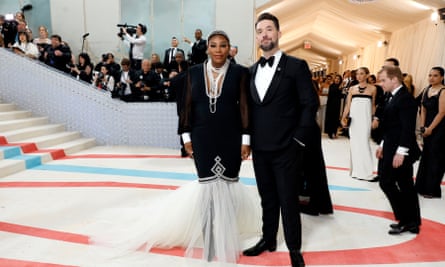
Where Alex Ferguson tried to keep a young Beckham’s focus on kicking a ball, sports teams now bring in fashion creatives to strengthen the connection with style.
Ronnie Fieg is the designer for American streetwear brand Kith. He became the creative director of the New York Knicks basketball team last year and has created a uniform and merchandise for the team.
Crystal Palace have consultant Kenny Annan-Jonathan as creative director to oversee clothing lines and fashion collaborations. “Football teams are brands unto themselves so they want to have brand affiliation with things that are cool and that people actually want to wear,” says Armstrong.
Professional athletes, who have notoriously short careers on the actual pitch or field, have realised that fashion is a revenue stream they can pursue afterwards, too.
“A lot of them decide to sculpt their personal brands from the outset of their careers, rather than later down the line,” says Miller. “Fashion is the perfect way to open the profile up to an audience beyond sport.”
after newsletter promotion
This has led to the growth of a new micro-industry – the sports stylist, as Miller documented in a recent report. Working with experts on what they wear, athletes can put themselves on the radar of brands in the hope of scoring lucrative deals. American basketball players are leading the way in this. They are photographed in the tunnel leading to the court, with @leaguefits documenting their designer style.
“They are allowed to wear their own clothes to games, so they have that freedom to actually express themselves,” says stylist Algen Hamilton, who works with Premier League footballers, including Reiss Nelson and Trevor Chalobah. “The rules are different to the rules in football. The Premier League is very traditional.”
The Women’s Super League, meanwhile, is a less tapped market. Stylist Kiera Liberati has worked with female footballers and says there is a long way to go until one has the fashion impact of, say, Beckham. “A lot of the [England team] are still quite tomboyish and wearing sports brands, but I do think it will come … Right now, whenever we see a shoot with a female footballer, there’s an England flag in the background or they’re wearing a football top.”
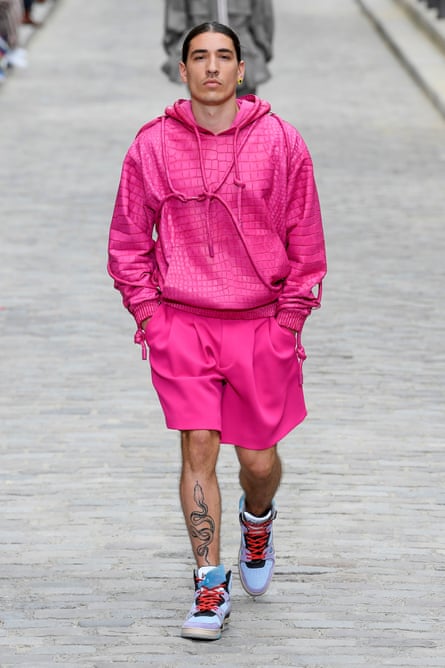
If football and basketball dominate the conversation, other branches of the sports-entertainment industry are hot on their heels. Troi Anthoni is a stylist who works with wrestlers – including Seth Rollins, a man that American GQ labelled WWE’s “undisputed fashion king” in August, thanks to his brightly coloured suits and the fact he once wore art collective MSCHF’s “big red boots”, the cartoonish footwear that has become an internet phenomenon.
Anthoni says Rollins is opening the minds of wrestling fans. “It’s like ‘You may not know what this is, because you guys wear T-shirts and jeans and merch and stuff like that, but this is high fashion’. Inspiration is being spotted on Monday nights every week.”
Athletics has also “really taken a big leap forward” in terms of fashion, says Armstrong. “There are stars on the rise like Sha’Carri Richardson who are bringing personality back into the sport that I think has been diminished over the last few years. It’ll be exciting to see how that plays out.”
It’s likely to play out spectacularly over the next year. In July, LVMH announced its sponsorship of Paris 2024, using its various labels for different activities. Chaumet jewellery will make the Olympic and Paralympic medals, and Sephora makeup will be involved in events along the Olympic torch route. LVMH has also started to unveil a group of athletes that it will be directly supporting at the Olympics. Names so far include swimmer Léon Marchand and gymnast Mélanie de Jesus dos Santos.
For the relationship between sports and fashion, it looks like the games have only just begun.

